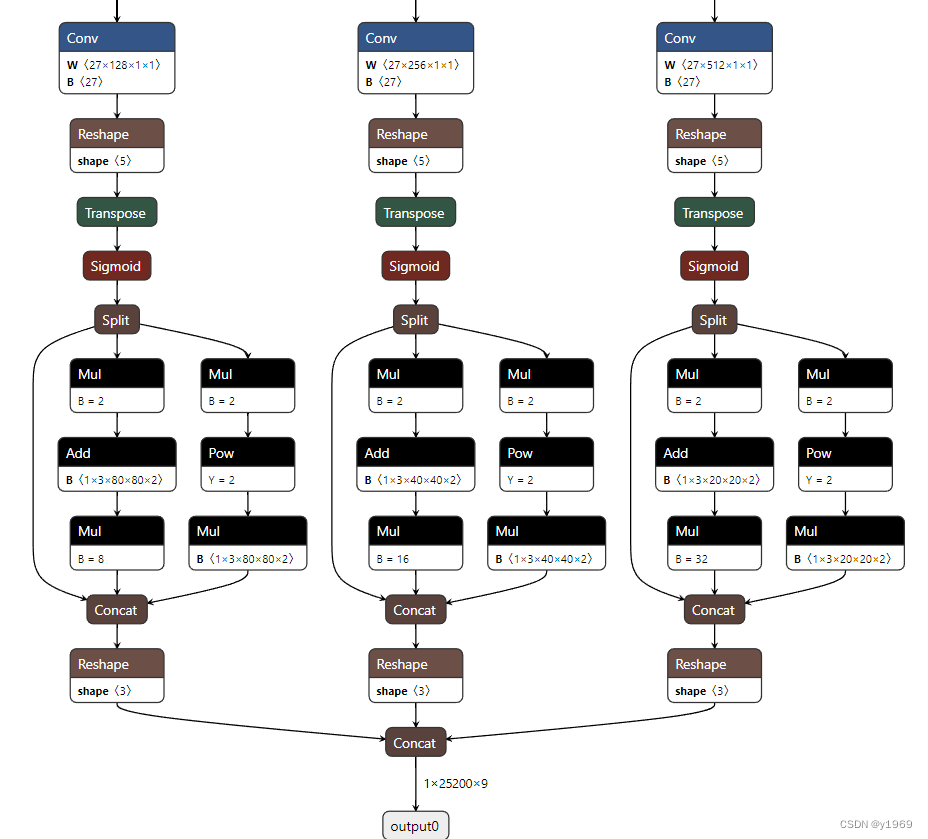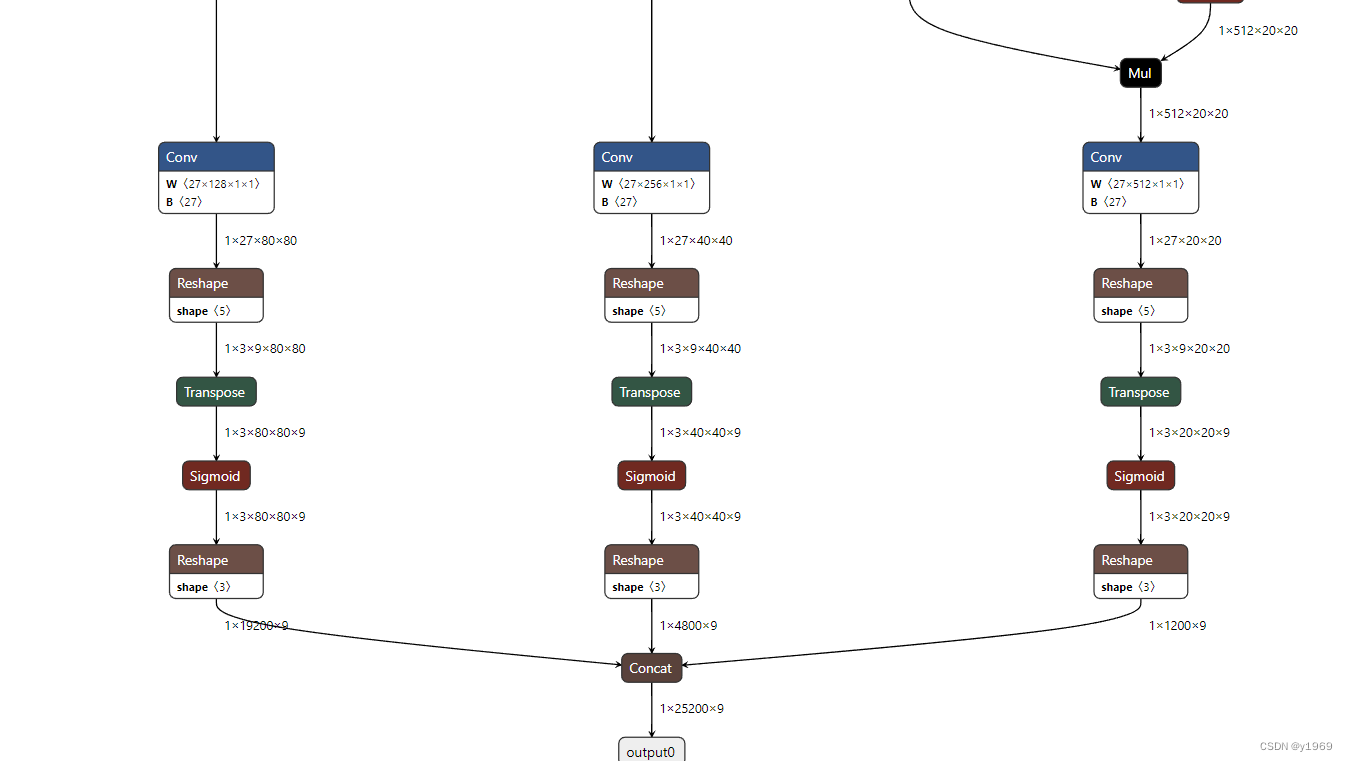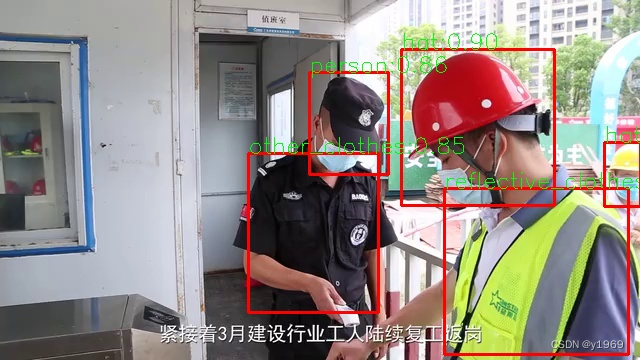yolov5画框重复、大框包小框问题解决,c++、python代码调用onnx |
您所在的位置:网站首页 › yolov4识别颜色 › yolov5画框重复、大框包小框问题解决,c++、python代码调用onnx |
yolov5画框重复、大框包小框问题解决,c++、python代码调用onnx
|
yolov5在训练完成后,获取模型(pt)文件,或者转为onnx文件,对图片进行推理时,会出现以下情况,大框包小框,会导致,明明场景中只有一个目标物而识别出两个或者更多目标物,且画出的框均标记在目标物上,在单张图目标物较多的场景该现象更为严重,具体情况如下图所示。
如上图所示,右上角帽子的标签就出现了,大框包小框的现象。 通过查找资料,发现是由于最新的代码,在生成模型,及导出onnx模型时,将anchor box decode过程包含在内。导出的onnx模型如下图所示(仅展示anchor box decode过程)。
用opencv的dnn模块做yolov5目标检测_nihate的博客-CSDN博客_opencv yolov5 这里有(上面链接),更改代码处理模型的详细过程,总结其中与之相关部分的代码及处理步骤如下所示(或有不同,是在使用时由于报错,对代码做了一点修改)。 models/yolo.py中的detect类中做一下修改(sigmoid可加可不加)
代码片段(可以复制代码片段) def forward(self, x): # x = x.copy() # for profiling z = [] # inference output # if torch.onnx.is_in_onnx_export(): for i in range(self.nl): # 分别对三个输出层处理 x[i] = self.m[i](x[i]) # conv bs, _, ny, nx = x[i].shape # x(bs,255,20,20) to x(bs,3,20,20,85) x[i] = x[i].view(bs, self.na, self.no, ny, nx).permute(0, 1, 3, 4, 2).contiguous() y = x[i].sigmoid() z.append(y.view(bs, -1, self.no)) # z.append(x[i].view(bs, self.na * nx * ny, self.no)) return torch.cat(z, 1)在export.py文件中添加 def my_export_onnx @try_export def my_export_onnx(model, im, file, opset, dynamic, prefix=colorstr('ONNX:')): print('anchors:', model.yaml['anchors']) wtxt = open('class.names', 'w') for name in model.names: wtxt.write(name+'\n') wtxt.close() # YOLOv5 ONNX export # print(im.shape) if not dynamic: f = os.path.splitext(file)[0] + '.onnx' torch.onnx.export(model, im, f, verbose=False, opset_version=12, input_names=['images'], output_names=['output']) else: f = os.path.splitext(file)[0] + '_dynamic.onnx' torch.onnx.export(model, im, f, verbose=False, opset_version=12, input_names=['images'], output_names=['output'], dynamic_axes={'images': {0: 'batch', 2: 'height', 3: 'width'}, # shape(1,3,640,640) 'output': {0: 'batch', 1: 'anchors'} # shape(1,25200,85) }) try: import cv2 net = cv2.dnn.readNet(f) except: exit(f'export {f} failed') exit(f'export {f} sucess')同时修改export.py文件中的 def export_onnx 。 代码如下所示 @try_export def export_onnx(model, im, file, opset, dynamic, simplify, prefix=colorstr('ONNX:')): # YOLOv5 ONNX export check_requirements('onnx') # ============== 2022.12.14剪枝yolov5的decode部分添加判断代码======================== my_export_onnx(model, im, file, opset, False, simplify) import onnx LOGGER.info(f'\n{prefix} starting export with onnx {onnx.__version__}...') f = file.with_suffix('.onnx')修改完成后,使用下述命令生成onnx模型文件 python export.py --weights yolov5s.pt --img 640 --batch 1 --include=onnx --simplify改过得onnx模型文件,anchor box decode过程如下图所示
同时,模型推理代码也需要进行更改,python代码如下 import cv2 import argparse import numpy as np class yolov5(): def __init__(self, modelpath, confThreshold=0.5, nmsThreshold=0.5, objThreshold=0.5): with open(r'F:\XunLeiDownLoad\yolov5-v6.1-opencv-onnxrun-main\opencv/safetyclass.names', 'rt') as f: self.classes = f.read().rstrip('\n').split('\n') self.num_classes = len(self.classes) if modelpath.endswith('6.onnx'): self.inpHeight, self.inpWidth = 1280, 1280 anchors = [[19, 27, 44, 40, 38, 94], [96, 68, 86, 152, 180, 137], [140, 301, 303, 264, 238, 542], [436, 615, 739, 380, 925, 792]] self.stride = np.array([8., 16., 32., 64.]) else: self.inpHeight, self.inpWidth = 640, 640 anchors = [[10, 13, 16, 30, 33, 23], [30, 61, 62, 45, 59, 119], [116, 90, 156, 198, 373, 326]] self.stride = np.array([8., 16., 32.]) self.nl = len(anchors) self.na = len(anchors[0]) // 2 self.grid = [np.zeros(1)] * self.nl self.anchor_grid = np.asarray(anchors, dtype=np.float32).reshape(self.nl, -1, 2) self.net = cv2.dnn.readNet(modelpath) self.confThreshold = confThreshold self.nmsThreshold = nmsThreshold self.objThreshold = objThreshold self._inputNames = '' def resize_image(self, srcimg, keep_ratio=True, dynamic=False): top, left, newh, neww = 0, 0, self.inpWidth, self.inpHeight if keep_ratio and srcimg.shape[0] != srcimg.shape[1]: hw_scale = srcimg.shape[0] / srcimg.shape[1] if hw_scale > 1: newh, neww = self.inpHeight, int(self.inpWidth / hw_scale) img = cv2.resize(srcimg, (neww, newh), interpolation=cv2.INTER_AREA) if not dynamic: left = int((self.inpWidth - neww) * 0.5) img = cv2.copyMakeBorder(img, 0, 0, left, self.inpWidth - neww - left, cv2.BORDER_CONSTANT, value=(114, 114, 114)) # add border else: newh, neww = int(self.inpHeight * hw_scale), self.inpWidth img = cv2.resize(srcimg, (neww, newh), interpolation=cv2.INTER_AREA) if not dynamic: top = int((self.inpHeight - newh) * 0.5) img = cv2.copyMakeBorder(img, top, self.inpHeight - newh - top, 0, 0, cv2.BORDER_CONSTANT, value=(114, 114, 114)) else: img = cv2.resize(srcimg, (self.inpWidth, self.inpHeight), interpolation=cv2.INTER_AREA) return img, newh, neww, top, left def _make_grid(self, nx=20, ny=20): xv, yv = np.meshgrid(np.arange(ny), np.arange(nx)) return np.stack((xv, yv), 2).reshape((-1, 2)).astype(np.float32) def preprocess(self, img): img = cv2.cvtColor(img, cv2.COLOR_BGR2RGB) img = img.astype(np.float32) / 255.0 return img def postprocess(self, frame, outs, padsize=None): frameHeight = frame.shape[0] frameWidth = frame.shape[1] newh, neww, padh, padw = padsize ratioh, ratiow = frameHeight / newh, frameWidth / neww # Scan through all the bounding boxes output from the network and keep only the # ones with high confidence scores. Assign the box's class label as the class with the highest score. confidences = [] boxes = [] classIds = [] for detection in outs: if detection[4] > self.objThreshold: scores = detection[5:] classId = np.argmax(scores) confidence = scores[classId] * detection[4] if confidence > self.confThreshold: center_x = int((detection[0] - padw) * ratiow) center_y = int((detection[1] - padh) * ratioh) width = int(detection[2] * ratiow) height = int(detection[3] * ratioh) left = int(center_x - width * 0.5) top = int(center_y - height * 0.5) confidences.append(float(confidence)) boxes.append([left, top, width, height]) classIds.append(classId) # Perform non maximum suppression to eliminate redundant overlapping boxes with # lower confidences. indices = cv2.dnn.NMSBoxes(boxes, confidences, self.confThreshold, self.nmsThreshold).flatten() for i in indices: box = boxes[i] left = box[0] top = box[1] width = box[2] height = box[3] frame = self.drawPred(frame, classIds[i], confidences[i], left, top, left + width, top + height) return frame def drawPred(self, frame, classId, conf, left, top, right, bottom): # Draw a bounding box. cv2.rectangle(frame, (left, top), (right, bottom), (0, 0, 255), thickness=4) label = '%.2f' % conf label = '%s:%s' % (self.classes[classId], label) # Display the label at the top of the bounding box labelSize, baseLine = cv2.getTextSize(label, cv2.FONT_HERSHEY_SIMPLEX, 0.5, 1) top = max(top, labelSize[1]) # cv.rectangle(frame, (left, top - round(1.5 * labelSize[1])), (left + round(1.5 * labelSize[0]), top + baseLine), (255,255,255), cv.FILLED) cv2.putText(frame, label, (left, top - 10), cv2.FONT_HERSHEY_SIMPLEX, 1, (0, 255, 0), thickness=2) return frame def detect(self, srcimg): img, newh, neww, padh, padw = self.resize_image(srcimg) blob = cv2.dnn.blobFromImage(img, scalefactor=1 / 255.0, swapRB=True) # blob = cv2.dnn.blobFromImage(self.preprocess(img)) # Sets the input to the network self.net.setInput(blob, self._inputNames) # Runs the forward pass to get output of the output layers outs = self.net.forward(self.net.getUnconnectedOutLayersNames())[0].squeeze(axis=0) # inference output row_ind = 0 for i in range(self.nl): h, w = int(self.inpHeight / self.stride[i]), int(self.inpWidth / self.stride[i]) length = int(self.na * h * w) if self.grid[i].shape[2:4] != (h, w): self.grid[i] = self._make_grid(w, h) outs[row_ind:row_ind + length, 0:2] = (outs[row_ind:row_ind + length, 0:2] * 2. - 0.5 + np.tile( self.grid[i], (self.na, 1))) * int(self.stride[i]) outs[row_ind:row_ind + length, 2:4] = (outs[row_ind:row_ind + length, 2:4] * 2) ** 2 * np.repeat( self.anchor_grid[i], h * w, axis=0) row_ind += length srcimg = self.postprocess(srcimg, outs, padsize=(newh, neww, padh, padw)) return srcimg if __name__ == "__main__": parser = argparse.ArgumentParser() parser.add_argument('--imgpath', type=str, default=r'E:\code\detect\yolov5\dataset\safety_clothing\test_safety_clothing\images1\398404624-1-16_6675.jpg', help="image path") parser.add_argument('--modelpath', type=str, default=r'E:\code\detect\yolov5\runs\train\all_safetly\best_all_che.onnx') parser.add_argument('--confThreshold', default=0.3, type=float, help='class confidence') parser.add_argument('--nmsThreshold', default=0.5, type=float, help='nms iou thresh') parser.add_argument('--objThreshold', default=0.3, type=float, help='object confidence') args = parser.parse_args() yolonet = yolov5(args.modelpath, confThreshold=args.confThreshold, nmsThreshold=args.nmsThreshold, objThreshold=args.objThreshold) srcimg = cv2.imread(args.imgpath) srcimg = yolonet.detect(srcimg) winName = 'Deep learning object detection in OpenCV' cv2.namedWindow(winName, 0) cv2.imshow(winName, srcimg) cv2.waitKey(0) cv2.destroyAllWindows()safetyclass.names 为标签文件,下图是截图展示
c++推理代码如下 #include #include #include #include #include #include using namespace cv; using namespace dnn; using namespace std; struct Net_config { float confThreshold; // Confidence threshold float nmsThreshold; // Non-maximum suppression threshold float objThreshold; //Object Confidence threshold string modelpath; }; //int endsWith(const string& s, const string& sub) { // return s.rfind(sub) == (s.length() - sub.length()) ? 1 : 0; //} const float anchors_640[3][6] = { {10.0, 13.0, 16.0, 30.0, 33.0, 23.0}, {30.0, 61.0, 62.0, 45.0, 59.0, 119.0}, {116.0, 90.0, 156.0, 198.0, 373.0, 326.0} }; //const float anchors_1280[4][6] = { {19, 27, 44, 40, 38, 94},{96, 68, 86, 152, 180, 137},{140, 301, 303, 264, 238, 542}, // {436, 615, 739, 380, 925, 792} }; class YOLO { public: explicit YOLO(const Net_config& config); void detect(Mat& frame); private: float* anchors; int num_stride; int inpWidth; int inpHeight; vector class_names; // int num_class; float confThreshold; float nmsThreshold; float objThreshold; const bool keep_ratio = true; Net net; void drawPred(float conf, int left, int top, int right, int bottom, Mat& frame, int classid); Mat resize_image(const Mat& srcimg, int *newh, int *neww, int *top, int *left) const; }; YOLO::YOLO(const Net_config& config) { this->confThreshold = config.confThreshold; this->nmsThreshold = config.nmsThreshold; this->objThreshold = config.objThreshold; this->net = readNet(config.modelpath); // ifstream ifs("F:\\XunLeiDownLoad\\yolov5-v6.1-opencv-onnxrun-main\\opencv/class.names"); ifstream ifs(R"(F:\XunLeiDownLoad\yolov5-v6.1-opencv-onnxrun-main\opencv/safetyclass.names)"); string line; while (getline(ifs, line)) this->class_names.push_back(line); // this->num_class = class_names.size(); // if (endsWith(config.modelpath, "6.onnx")) // { // anchors = (float*)anchors_1280; // this->num_stride = 4; // this->inpHeight = 1280; // this->inpWidth = 1280; // } // else // { anchors = (float*)anchors_640; this->num_stride = 3; this->inpHeight = 640; this->inpWidth = 640; // } } Mat YOLO::resize_image(const Mat& srcimg, int *newh, int *neww, int *top, int *left) const { int srch = srcimg.rows, srcw = srcimg.cols; *newh = this->inpHeight; *neww = this->inpWidth; Mat dstimg; if (this->keep_ratio && srch != srcw) { float hw_scale = (float)srch / srcw; if (hw_scale > 1) { *newh = this->inpHeight; *neww = int(this->inpWidth / hw_scale); resize(srcimg, dstimg, Size(*neww, *newh), INTER_AREA); *left = int((this->inpWidth - *neww) * 0.5); copyMakeBorder(dstimg, dstimg, 0, 0, *left, this->inpWidth - *neww - *left, BORDER_CONSTANT, 114); } else { *newh = (int)this->inpHeight * hw_scale; *neww = this->inpWidth; resize(srcimg, dstimg, Size(*neww, *newh), INTER_AREA); *top = (int)(this->inpHeight - *newh) * 0.5; copyMakeBorder(dstimg, dstimg, *top, this->inpHeight - *newh - *top, 0, 0, BORDER_CONSTANT, 114); } } else { resize(srcimg, dstimg, Size(*neww, *newh), INTER_AREA); } return dstimg; } void YOLO::drawPred(float conf, int left, int top, int right, int bottom, Mat& frame, int classid) // Draw the predicted bounding box { //Draw a rectangle displaying the bounding box rectangle(frame, Point(left, top), Point(right, bottom), Scalar(0, 0, 255), 2); //Get the label for the class name and its confidence string label = format("%.2f", conf); label = this->class_names[classid] + ":" + label; //Display the label at the top of the bounding box int baseLine; Size labelSize = getTextSize(label, FONT_HERSHEY_SIMPLEX, 0.5, 1, &baseLine); top = max(top, labelSize.height); //rectangle(frame, Point(left, top - int(1.5 * labelSize.height)), Point(left + int(1.5 * labelSize.width), top + baseLine), Scalar(0, 255, 0), FILLED); putText(frame, label, Point(left, top), FONT_HERSHEY_SIMPLEX, 0.75, Scalar(0, 255, 0), 1); } void YOLO::detect(Mat& frame) { int newh = 0, neww = 0, padh = 0, padw = 0; Mat dstimg = this->resize_image(frame, &newh, &neww, &padh, &padw); Mat blob = blobFromImage(dstimg, 1 / 255.0, Size(this->inpWidth, this->inpHeight), Scalar(0, 0, 0), true, false); this->net.setInput(blob); vector outs; this->net.forward(outs, this->net.getUnconnectedOutLayersNames()); int num_proposal = outs[0].size[1]; int nout = outs[0].size[2]; if (outs[0].dims > 2) { outs[0] = outs[0].reshape(0, num_proposal); } /generate proposals vector confidences; vector boxes; vector classIds; float ratioh = (float)frame.rows / newh, ratiow = (float)frame.cols / neww; int n = 0, q = 0, i = 0, j = 0, row_ind = 0; ///xmin,ymin,xamx,ymax,box_score,class_score auto* pdata = (float*)outs[0].data; for (n = 0; n < this->num_stride; n++) ///特征图尺度 { const float stride = pow(2, n + 3); int num_grid_x = (int)ceil((this->inpWidth / stride)); int num_grid_y = (int)ceil((this->inpHeight / stride)); for (q = 0; q < 3; q++) ///anchor { const float anchor_w = this->anchors[n * 6 + q * 2]; const float anchor_h = this->anchors[n * 6 + q * 2 + 1]; for (i = 0; i < num_grid_y; i++) { for (j = 0; j < num_grid_x; j++) { float box_score = pdata[4]; if (box_score > this->objThreshold) { Mat scores = outs[0].row(row_ind).colRange(5, nout); Point classIdPoint; double max_class_socre; // Get the value and location of the maximum score minMaxLoc(scores, 0, &max_class_socre, 0, &classIdPoint); max_class_socre *= box_score; if (max_class_socre > this->confThreshold) { const int class_idx = classIdPoint.x; float cx = (pdata[0] * 2.f - 0.5f + j) * stride; ///cx float cy = (pdata[1] * 2.f - 0.5f + i) * stride; ///cy float w = powf(pdata[2] * 2.f, 2.f) * anchor_w; ///w float h = powf(pdata[3] * 2.f, 2.f) * anchor_h; ///h int left = int((cx - padw - 0.5 * w)*ratiow); int top = int((cy - padh - 0.5 * h)*ratioh); confidences.push_back((float)max_class_socre); // boxes.push_back(Rect(left, top, (int)(w*ratiow), (int)(h*ratioh))); boxes.emplace_back(left, top, (int)(w*ratiow), (int)(h*ratioh)); classIds.push_back(class_idx); } } row_ind++; pdata += nout; } } } } // Perform non maximum suppression to eliminate redundant overlapping boxes with // lower confidences vector indices; /*dnn::NMSBoxes * 作用:根据给定的检测boxes和对应的scores进行NMS(非极大值抑制)处理 * NMSBoxes(bboxes, scores, score_threshold, nms_threshold, eta=None, top_k=None) 参数: boxes: 待处理的边界框 bounding boxes scores: 对于于待处理边界框的 scores score_threshold: 用于过滤 boxes 的 score 阈值 nms_threshold: NMS 用到的阈值 indices: NMS 处理后所保留的边界框的索引值 eta: 自适应阈值公式中的相关系数: * */ dnn::NMSBoxes(boxes, confidences, this->confThreshold, this->nmsThreshold, indices); // for (size_t i = 0; i < indices.size(); ++i) // { // int idx = indices[i]; // Rect box = boxes[idx]; // this->drawPred(confidences[idx], box.x, box.y, // box.x + box.width, box.y + box.height, frame, classIds[idx]); // } for (int idx : indices) { Rect box = boxes[idx]; this->drawPred(confidences[idx], box.x, box.y, box.x + box.width, box.y + box.height, frame, classIds[idx]); } } int main() { // Net_config yolo_nets = { 0.3, 0.5, 0.3, "F:\\XunLeiDownLoad\\yolov5-v6.1-opencv-onnxrun-main\\opencv/weights/yolov5s.onnx" }; Net_config yolo_nets = { 0.3, 0.5, 0.3, R"(E:\code\detect\yolov5\runs\train\all_safetly\best_all_che.onnx)" }; YOLO yolo_model(yolo_nets); string imgpath = R"(E:\code\detect\yolov5\dataset\safety_clothing\test_safety_clothing\images1\398404624-1-16_6675.jpg)"; Mat srcimg = imread(imgpath); yolo_model.detect(srcimg); string saveimg_path= R"(E:\code\detect\yolov5\testsave\safety2.jpg)"; imwrite(saveimg_path, srcimg); // static const string kWinName = "Deep learning object detection in OpenCV"; // namedWindow(kWinName, WINDOW_NORMAL); // imshow(kWinName, srcimg); // waitKey(5000); // destroyAllWindows(); }经过上述过程后图片的推理结果如下所示 可以看出,大框包小框的现象消失。 参考文章:用opencv的dnn模块做yolov5目标检测_nihate的博客-CSDN博客_opencv yolov5windows下最新yolov5转ncnn教程(支持u版yolov5(ultralytics版)v5.0)_五四三两幺-发射!的博客-CSDN博客_yolov5转换xnno 原代码地址:https://github.com/hpc203/yolov5-v6.1-opencv-onnxrun |
【本文地址】





